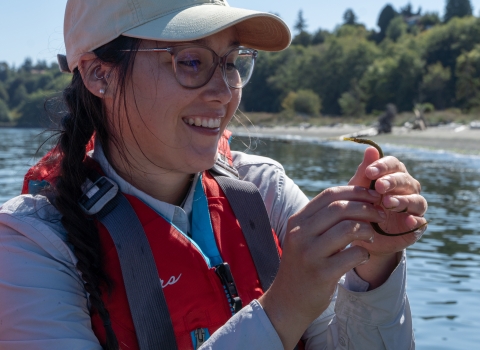A slow death
Open or uncapped vertical pipes spread on the landscape for many utilitarian purposes pose a very real hazard to wildlife, especially birds. Viewed from the air, these pipes appear to provide an attractive nest hole for a variety of small birds and other wildlife.
A bird flies in, looking for a place to build a nest. The tight confines of the pipe prevent the bird from extending their wings to fly, the smooth circular interior is impossible to climb. Trapped in a small space with no food or water, the bird struggles until it slowly dies of stress, starvation, or dehydration. Another bird flies into the hole, and the cycle continues. Unfortunately, this is the reality for many birds and other animals each year.
Impacts to wildlife
Cavity nesters are not the only victims of these pipes. Migrating birds may seek shelter from the elements in hollow pipes or attempt to perch on them. According to California Audubon, nearly 45 different species of birds have been recovered from open pipes. Bird species commonly trapped include flycatchers, bluebirds, woodpeckers, sparrows, shrikes, kestrels, and even owls. In addition to birds, lizards, snakes, small mammals and insects have also been found inside pipes. In 2009, Audubon California removed a 20 foot tall pipe from an abandoned irrigation system. In place for 50 years, the pipe yielded the carcasses of hundreds of birds and animals, including kestrels, flickers, bluebirds, and fence lizards.
Pipes on the landscape
Audubon California has found that open vertical pipes are commonly used as sign posts, fence posts, survey markers, building plumbing vents, irrigation systems, and chimneys and it is easy to find them in both urban and rural areas. Pipes such as these often contain the remains of trapped animals.
There are often open pipes on top of residential and commercial buildings. California, Nevada, and Oregon state law prohibits open-topped pipes from being used as mining claim markers. U.S. Bureau of Land Management policy also encourages wildlife-safe monuments that do not include open cap-less pipes to mark mining claims. However, open PVC pipes are often used for other purposes on the landscape.
Cover your pipes!
There is a simple solution to this problem: cover open pipes! By capping or covering open pipes, birds, snakes, and other animals are prevented from becoming trapped. Inspect your property, identify all open vertical pipes, and close them off. The cap or cover does not have to be expensive, but it does need to be secure and not easily dislodged by the wind or other disturbance. Pipe caps may be purchased or covers can be easily constructed. A simple cement cap is a simple and cost effective solution.
For pipes that are in place to vent air or gas, screens can be used to prevent entry. Open pipes can also be filled with rocks or sand.
Remove derelict pipes!
Removal of open pipes is another solution to the problem; but it is important that the landowner and the purpose of the pipe be identified prior to removal. If the landowner is willing, then removal is an easy way to reduce pipe-related mortalities.
Spread the word!
Many people do not realize the hazards that open pipes pose to birds and other wildlife. Education is often the best prevention. The U.S. Bureau of Land Management, Nevada Department of Wildlife, Audubon California, and the American Bird Conservancy all have ongoing outreach efforts to inform the public of the hazards of open pipes to wildlife and have facilitated pipe removal on public lands.
Please help us to reach out to your community. Share this information with your family, friends, neighbors, or co-workers. Encourage others to inspect their personal or commercial holdings for open pipes. Participate in coordinated volunteer efforts to remove or cover open pipes in your area. Let’s work together to keep our landscape free of open pipes to prevent the untimely death of migratory birds and other wildlife.



